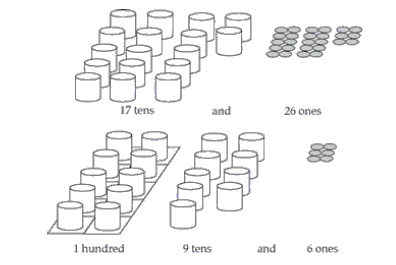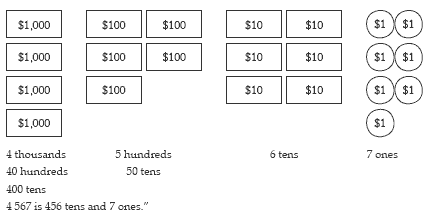Find out how many ones, tens, hundreds and thousands are in all of a whole number.
Number Framework Stage 6
Blank Tens Frames
Using Materials
Initially use beans or other single items, such as ice-block sticks or unilink cubes, to model numbers because this is a proportional representation of place value, that is, a canister of ten beans is really ten times more than a single bean and a tens frame holding ten canisters really contains ten times more than a single canister. Numeracy money is a non-proportional representation but is useful because it is easier to manipulate for larger numbers.
Ask the students to make three-digit numbers using beans, e.g., 258 would be modelled as:
Ask the students “nested” place value questions such as:
How many tens are in our number altogether? Where are all of those tens?” (There are 20 tens in the 2 hundreds, and 5 tens in the tens, that’s 25 tens.)
- “How many ones are in our number altogether? Where are all of those ones?”(There are 200 ones in the 2 hundreds, 50 ones in the 5 tens, and 8 ones, that’s 258 ones.)
Provide several examples and record students’ statements about the same number using words and symbols:
- 3 hundreds and 6 tens and 4 ones 36 tens and 4 ones 364 ones
- 4 hundreds and 7 tens and 3 ones 47 tens and 3 ones 473 ones.
Ask the students to think in reverse by getting them to combine ones and tens, e.g.,“Make this number: 17 tens and 26 ones. Find the simplest way you could say this number.”
Look for students to combine ten ones as tens, ten tens as hundreds, and so on.

Other examples might be, “Make 29 tens and 13 ones (303). Make 38 tens and 38 ones (418).”
Extend the nested place value concept to thousands and ten thousands, modelling with play money, e.g., “Make 5 671. How many hundreds are there altogether?” (56)
“Where are all the hundreds?” “How many tens are there altogether?” (567) “Where are all the tens?” and so on.Students may need to build the amounts with hundred dollar notes and ten dollar notes respectively to see these relationships: “Make 18 hundreds, 26 tens, and 35 ones. What is the simplest way to make this number with money?”
Using Imaging
In this phase of the lesson, the focus is on students anticipating the actions on materials, either beans or play money. If students experience difficulty with anticipating, it may be necessary to fold back to manipulating materials or drawing diagrams to model the physical situation. In the process of this imaging phase,recording in word form needs to be connected to the formal arithmetic symbols.
Pose problems such as:
- “Tess has $4,567. She thinks she will feel richer if she changes all her $1,000 and $100 notes for $10 notes. How many $10 notes will she have?”
- “Afisa has this in his money box: seven $100 notes, sixty-seven $10 notes, and twenty-five $1 coins. He goes to the bank. How much money is he depositing?”
Allow students to record diagrams to work out the problems and record their thinking using words and symbols, e.g.: “Tess’s money is 4 thousands, 5 hundreds, 6 tens, and 7 ones.
Using Number Properties
In this phase of the lesson, students need to operate on the numbers rather than relying on images of actions on materials. It is likely that they will need to record information to ease the memory load involved in these problems. Allow them to develop their own systems of recording but encourage them to progressively refine these systems into succinct forms.
Problem: “How many tens in 9 056?” (See the Tess “feeling richer” context above.)
Possible recording:
leading to 9 056 = 905 tens and 6 ones
Problem: “How much is 56 hundreds, 63 tens, and 17 ones?”
Possible recording:
.gif)
leading to 56 hundreds, 63 tens, and 17 ones equals 6 thousands, 2 hundreds, 4 tens, and 7 ones.
5 600 + 630 + 17 = 6 247


